Category Archives: All UkulelePlay! Blog Posts
The Circle from New Lyrics for a New Album

Do your thoughts run in a circle?
Round and round and round they go.
Do they chase the tail that wags them
as they wander to and fro?
Do they claw the cage, looking for cracks,
then patch up each hole and chink?
And rebounding fall with every fighting blow,
as the walls begin to shrink?
It doesn’t have to be this way, though it might just take a breath,
to realize resistance fortifies the chains of death.
Be still …
Let go …
Breathe slow …
And know …
Your mind …
Will find …
The climb …
In time …
These walls … You’re never good enough.
Will fade … You’ll never see it through.
Disolv- … You’ll never find success,
-ing shade … no matter what you try to do.
Into … You cannot do it now.
A mist … You’ll never, ever heal.
Cannot … You’re a fraud, a fake, a cow!
Persist … You’re a toppled spinning wheel.
Your hope- … When he tells me I am good enough,
-ful song … When he says that we can see it through,
and bless- … When he whispers ‘I have done the work,’
-ing long … ‘Death and hell are now behind you.’
Will thank- … Will I listen, let go, follow?
-ful play … Will I breathe into his grace?
To free … Let my heart float up in wonder?
The day … Let joy accept its rightful place.
When you … Just breathe.
Release … Just breathe.
And striv- … Just breathe.
-ing cease … Just breathe.
Let grace …
Increase …
And thrive …
In peace.
_______
Copyright 2025 M. Ryan Taylor
Note: As far as the content … It took a complete collapse for me to realize that the circular loops of thought I have struggled with for most of my life were actually part of a sickness. The breakdown forced me to deal with this and the problem of scrupulosity (a form of OCD that I never knew existed until I sought ways to deal with ‘unwanted intrusive thoughts’ – there are some good books on this out there if you need help). Just knowing that this was a sickness was truly half the battle. Through meditation and prayer, I’ve gotten pretty good at letting these thought loops dissipate naturally, without resistance (fighting the thoughts or arguing with myself), by gently refocussing my mind back to my breath, my walk, nature, a phrase, or whatever else I’ve chosen to focus on as a focal point (playing an instrument is another good example). Sometimes it is easier than other times, but knowing that fighting with myself (shoring up or trying to argue against a thought) is a counterproductive battle that one can only lose (because it only strengthens the neural pathways in your brain related to that thought). The answer is to recognize, but not engage. “Ah, there you are. Sorry thought, I’ve got this other thing I need to focus on. Have a nice day!”
There’s some unusual form going on here … a verse, a bridge and then 4 choruses with a duet coming in the the second and third chorus (like a call and response). I can hear what’s going on musically for this in my head, so I think it will be effective once I get it all down.
Photo: Louis Reed
Tomorrow Never Comes from New Lyrics for a New Album

Sounding like a dirge or psalm depending where you stand,
In the pit of sorrow, or playing with the band,
Hear the cry of hope or doom, the voice of distant drums:
“There’s no tomorrow … tomorrow never comes.”
Breathe in, breathe out,
Zip up, or shout,
Decay or sprout,
Breath in, breathe out.
Dream, rise, rub my eyes,
Rinse, drink, pray and think,
Read, write, grab a bite,
Work, play, release the day.
Waking, walking, working, shirking,
Coping, calling, rising, falling,
Sitting, sipping, racing, chasing,
Hating, loving, holding, shoving …
Now, right now is all there is;
Osmium and carbon fizz
Passing through the dark unknown,
A point of light is all we’re shown.
Knowing all that came before
Brought this moment to the floor,
Lightly hold our little hopes,
or sink hearts with heavy ropes.
Sounding like a dirge or psalm depending where you stand,
In the pit of sorrow, or playing with the band,
Hear the cry of hope or doom, the voice of distant drums:
“There’s no tomorrow … tomorrow never comes.”
_______
Copyright 2025 M. Ryan Taylor
Note: This is me trying to wrap my brain around the paradox that ‘now’ is really all there is. We may plan for the future, dream about it, prepare for what we think it may hold, but these are just thoughts … and yet we know the thoughts and actions of the past have shaped our present reality, what we are experiencing now. Jesus pointedly told us, “Take … no thought for the morrow; for the morrow shall take thought for the things of itself …” which is in dynamic tension with the parable of the ten virgins (and other passages), where it is emphasized how important it is to be prepared (in this case with oil for the wedding feast). I guess the short takeaway would be, “Prepare, but don’t worry. Trust God, but keep fighting the good fight.”
Photo: Christian Lue via Unsplash
Let Your Light So Shine from New Lyrics for a New Album
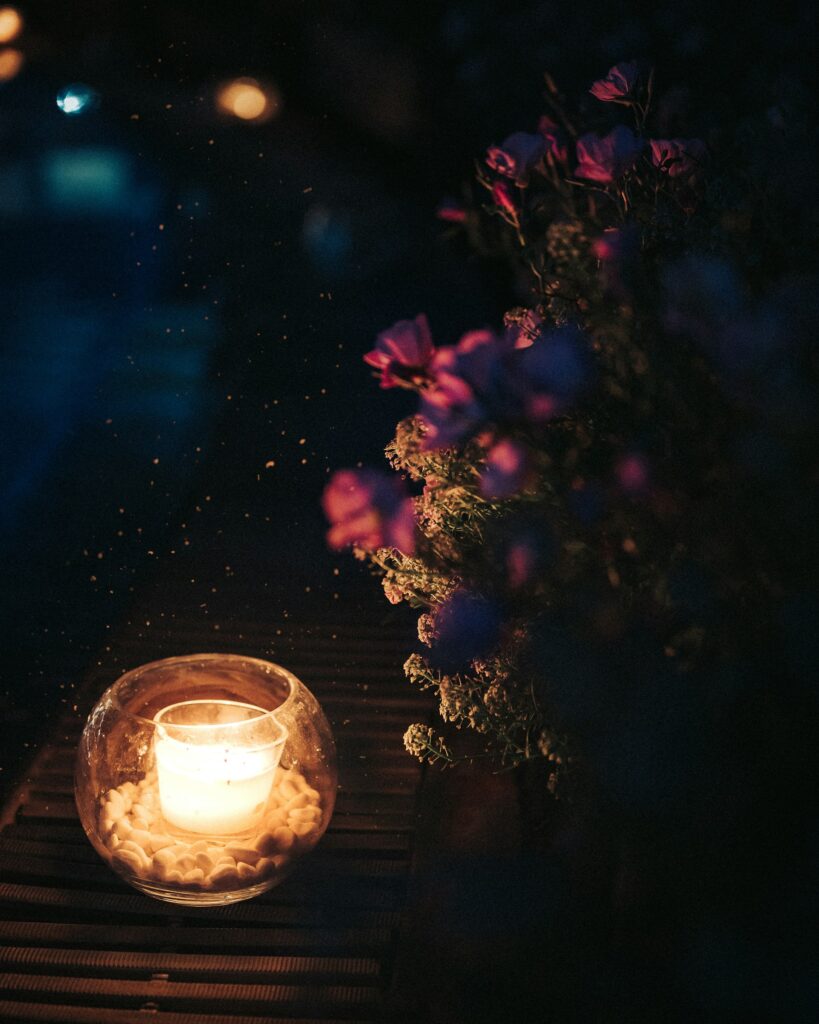
Pretending you’re not brilliant is not humility.
Stop building blinds about to hide your light.
Your lamp is lit, your candle burns, so we can clearly see
The patch of wonder ’round you in the night.
Let your light so shine;
Let it cast a glow
On the rough, on the fine,
So every child can know
What God freely gifts
To both yours and mine.
Through all the hurts and all the lifts,
Let your light so shine.
The scientist uncovers nature’s mystery,
The artist illustrates a point of history,
The poet through reflection, or the lover by affection,
Shine spotlights on the marvels in our sphere.
The rebel leads the fight for greater liberty,
The mystic looks within to find divinity,
Through the farmer’s garden soil, and the healer’s healing oil,
Each gift a fiery torch, when brought together make it clear
That God is good and he loves you. So …
Let your light so shine;
Let it cast a glow
On the rough, on the fine,
So every child can know
What God freely gifts
To both yours and mine.
Through all the hurts and all the lifts,
Let your light so shine.
No matter what your station,
You were born to illuminate creation.
Let your light so shine …
_______
Copyright 2025 M. Ryan Taylor
Note: I’ve reflected on Jesus’ call to be a light/salt since I was a youth, but I think I’m only beginning to understand how we are able to be the ‘light of the world’ and the ‘salt of the earth.’ Light helps us perceive what is there already through the sense of sight, and salt, never the main course, enhances the food at the table. My good works, your good works, everyone’s good works … they’re not the main event, but stand as a witness to the greatness of the giver of all good gifts.
Photo: Stefzn via Unsplash
Jesus Loves You from New Lyrics for a New Album

Eight degrees, walking to school under a sunrise rosy glow,
Boot stomping on the crunchy ice, conversing, “Hey, what’s new?”
We spot a finger-written message in the sparkling snow:
Hearts, like quote marks, framing up the words, “Jesus loves you.”
Later, strolling with my sweetheart on a lunchtime walk,
Around the block, up-down the hill, and past the park on cue,
We see more finger-written snow notes, glitter white, and talk
Of hearts and letters, winter warming, “Jesus loves you.”
I think about the sad, abandoned theater;
The empty shell we pass each day on main
Where on the old marquee, block letters, plain to see,
Spell out that “Jesus Loves You” through all weather, wind and rain.
And now I’m looking everywhere around to find those words
Reflected in the clouds or shining bright on morning dew,
In lullabies the wolves are singing to the desert birds,
When mothers whisper comfort, all cries out, “Jesus loves you.”
If life is overwhelming and you don’t know what to do,
Look up, around to hear the sound that “Jesus loves you.”
_______
Copyright © 2025 M. Ryan Taylor
Note: It actually pretty much played out as in this ‘slice of life’ from yesterday. Taavi and I walk to school together each morning and to spice things up I usually bring along some ‘conversation cards’ prompts. We saw this message in the snow (I went back later to photo this slightly melted version). Later, when walking with Dixie on our lunch break, we could see that this same person had tagged at least two other patches of snow around our block. It made us smile. This morning as I reflected on this, I thought of the old, abandoned theater on Main, which makes me a bit sad, but has had “Jesus Loves You” on the marquee ever since closing.
Sunshine Honeymoon from New Lyrics for a New Album
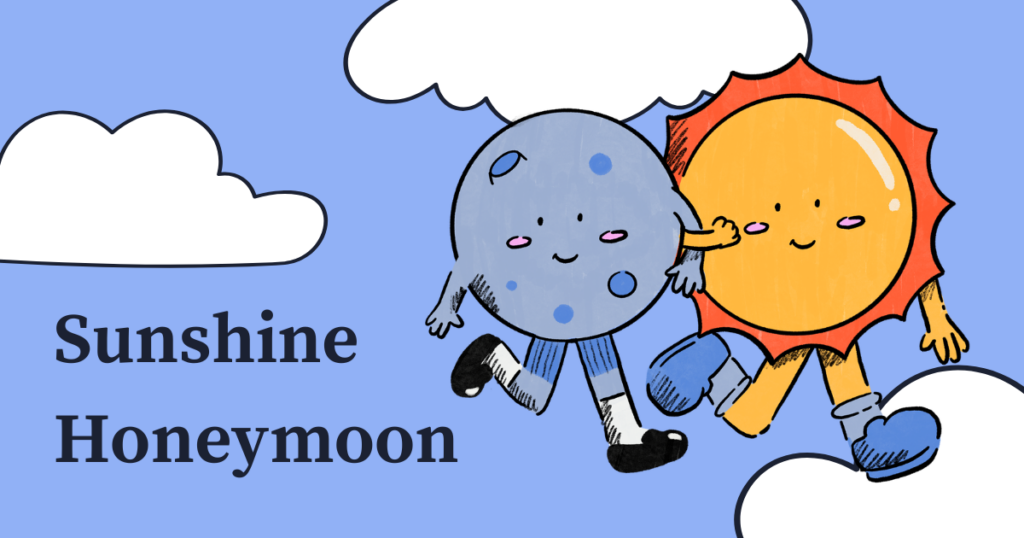
I’d like to sail the seas with you, or climb the mountains high,
Or get on board a rocket, cutie, and jet beyond the misty sky.
It doesn’t matter where we are, that day can’t come too soon,
As long as we’re together, tutti, we’re on a sunshine honeymoon.
Sunshine, sunshine honeymoon,
Spoon and croon, July to June,
Sunshine honeymoon each year,
As long as we’re together, dear.
I’d like to sail the seas with you, but drowning, lost in thought,
Keep throwing out those life lines, honey, eventually I will be caught,
Just reel me in, my angel love, pull up into the air,
And navigate to where it’s sunny; our secret island love affair.
Sunshine, sunshine honeymoon,
Spoon and croon, July to June,
Sunshine honeymoon each year,
As long as we’re together, dear.
Don’t ever let me float away,
But keep me anchored in your bay,
We’ll lay out on the sandy beach,
Careless of all that’s out of reach.
Sunshine, sunshine honeymoon,
Spoon and croon, July to June,
Sunshine honeymoon each year,
As long as we’re together, dear.
_______
Copyright 2025 M. Ryan Taylor
Note: The initial thought behind this song (pulling my circling thoughts back to my wife walking with me) led me somewhere I never really expected to go. Because of this, I had to go back and rewrite and reorder a lot for it to make sense, but I think it came out stronger, with a more hopeful, old-fashioned, and still wholly honest, song. I’m thinking of setting it in a 1920-40s style.
Shadow Play from New Lyrics for a New Album

If everything were roses, child,
from morn to night and dusk til dawn,
the perfume we once relished would
become a soporific yawn.
If everyday was bright with sun
and not a cloud in sight,
the world would wither, bake and crack
beneath that fiery blight.
If gems and pearls were everywhere
we’d trample them without a care.
If all we had to eat was rice,
how much would be an apple’s price?
So every prize has its criteria;
To taste an ice cube in Siberia
could not delight the thirsty child
like one born to the desert wild.
So celebrate the sweet, the sour, the bitter, salty way
we gather keepsakes, wounds and scars from living day to day;
And all the little deaths we die within this cabaret
bring meaning to the love that lights our hour of shadow play.
The earth is precious ’cause it’s rare,
this marbled speck floats on, out there,
with sun and moon through space to shine
without an end or finish line.
While free to fail, to fall in life,
the God who weeps with us through strife
provides a friend, the path, our way
to choose light in this shadow play.
So celebrate the sweet, the sour, the bitter, salty way
we gather keepsakes, wounds and scars from living day to day;
And all the little deaths we die within this cabaret
bring meaning to the love that lights our hour of shadow play.
If it is true that you are only happy as you’re grateful,
open your heart, let it rejoice, even when you’ve had a plateful.
So celebrate the sweet, the sour, the bitter, salty way
we gather keepsakes, wounds and scars from living day to day;
And all the little deaths we die within this cabaret
bring meaning to the love that lights our hour of shadow play.
_______
Copyright 2025 M. Ryan Taylor
Note: I finished this one after reflecting on a conversation I had with my brother about the experiences we’ve had the past few years.
Photo credit: Javier Allegue Barros via Unsplash
We Witness from New Lyrics for a New Album

When we rise and walk together,
watch the blooming fire of sun
climb up behind the mountains
and paint the every-changing sky … we witness.
When we climb into the canyon,
following the river bend,
see each flower wild rejoicing,
the birds sing their triumphant sigh … we witness.
We witness all the wondrous works your hand has set in motion.
We witness to the life you’ve formed in forest, desert, ocean.
We praise the guiding heart and mind behind these glorious arts;
As we witness, hope and peace take root and bloom within our hearts … we witness.
When we look to see our neighbor
faltering and lend a hand,
to steady them with power
we didn’t feel we ever had … we witness.
When we seek that gift within us,
flowing free, renewing life,
that graceful well dug for us,
where a single sip can make us glad … we witness.
We witness all the wondrous works your hand has set in motion.
We witness to the life you’ve formed in forest, desert, ocean.
We praise the guiding heart and mind behind these glorious arts;
As we witness, hope and peace take root and bloom within our hearts … we witness.
_______
Copyright 2025 M. Ryan Taylor
Note: I had the first verse and the chorus mostly nailed down a while back, but I had no idea what to do with a second verse until the thought came to me that witnessing to the goodness of God is not limited to a list of external wonders … there are wonders taking place within when we accept the ‘water’ Jesus offers, which he promises will become a “fountain of water springing up into everlasting life” … something we can only witness within ourselves.
Photo: Artem Sapegin via Unsplash
You Are the Universe from New Lyrics for a New Album

Will it make the world a better place
to watch the clouds float smoothly by,
or gaze into the wide expanse of space
to count the stars within the sky?
Will it matter if I write these words,
or paint, or sculpt my thoughts in clay;
classify the cheering calls of birds,
or close my eyes, listen and sway.
Did you really think that sitting still
would bring the world more quiet peace?
Forest bathing measure out goodwill?
Or morning sunshine joy release?
If you did, I’ll tell you where you stand,
you’ve made the world not one bit worse,
for while you’re nothing but a fleck of sand,
you also are the universe.
It’s important to feed the hungry,
and it’s key that we lift the poor.
Still, as much as we all thirst for water,
humanity’s thirsting for so much more.
_______
Copyright 2025 M. Ryan Taylor
Note: Do you ever feel like what you do isn’t important enough? That you ought to be digging wells in Africa, or some such thing? There’s a part of me that longs for that kind of adventure, but there’s another part of me that feels called to other things.
Photo: Alessandro Cavestro on Unsplash
Low Tide from New Lyrics for a New Album

Low tide,
there’s nowhere left to hide,
I fell asleep and dozed,
and now I’m all exposed.
Hear the echoes of the distant rain and thunder
that have fed and torn the distant waves asunder.
Every tide pool seems to hold a world of wonder,
where anemones slow dance with the sea stars in a trance.
Full moon,
not a moment come too soon;
seeing all the dark and bright,
curious shadows in the night.
Full moon.
I can see the hermit crabs brawl like beginners,
While the octopus waits still to grab his dinners,
Every urchin, muscle, snail, strive to be winners
in a motion slow and sleek, ever finding as they seek.
Low tide,
there’s nowhere left to hide,
I fell asleep and dozed,
and now I’m all exposed.
_______
Copyright 2025 M. Ryan Taylor
Note: Is this song about life in tide pools? or about watching the drama unfold within us when that secret life and inner conflict is ‘exposed’? How about both? When I started with the title ‘low tide’ I was definitely thinking of writing about hitting rock bottom, but then I thought about visiting the tide pools at Dana Point and walking among all these beautiful wonders that are only exposed when the water recedes. If you work at it, there comes a point when the scientist in you can dispassionately view the internal dramas found inside with curiosity, rather than get bogged down in despair; that’s one of the points of practicing meditation. For a music video, that will probably never get made, I thought it would be cool to have me singing the opening chorus and then zoom in on me ripping open my shirt and instead of my chest, finding this tide pool drama going on … sort of reminiscent of Peter Gabriel’s Digging in the Dirt video.
Photo: Dawn Casey via Pixabay
HAPPY Ukulele Workshop Video
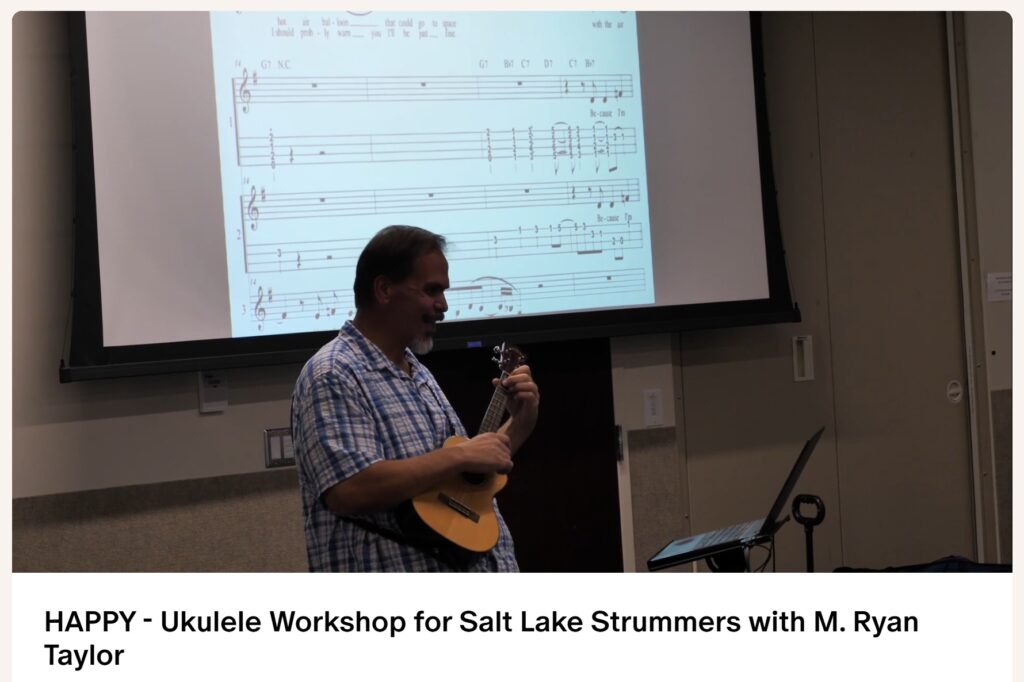
Catch this video at https://www.patreon.com/posts/happy-ukulele-m-114943003
Walk in Him
Visit PROJECT PAUL for free sheet music, mp3 & chord chart for this setting of Colossians 2:6-7, as well as all the other songs in this collection.
Walk in Him (Colossians 2:6-7)
As ye have therefore received Christ Jesus the Lord, so walk ye in him: Rooted and built up in him, and stablished in the faith, as ye have been taught, abounding therein with thanksgiving.
Open Mic: “The Cratchit’s Christmas Feast”
At the Uke Summerfest open mic in Bountiful, UT on 6/22/24 singing “The Cratchit’s Christmas Feast” from my new musical, A Christmas Carol: The Musical Experience. All the performance materials (script, sheet music & minus tracks) are available freely at carol.fablelight.org … A big “Thank You!” to Daniel Hulbert of Circuits & Strings for catching the moment on video.
A Christmas Carol: The Musical Experience (Free Sheet Music)
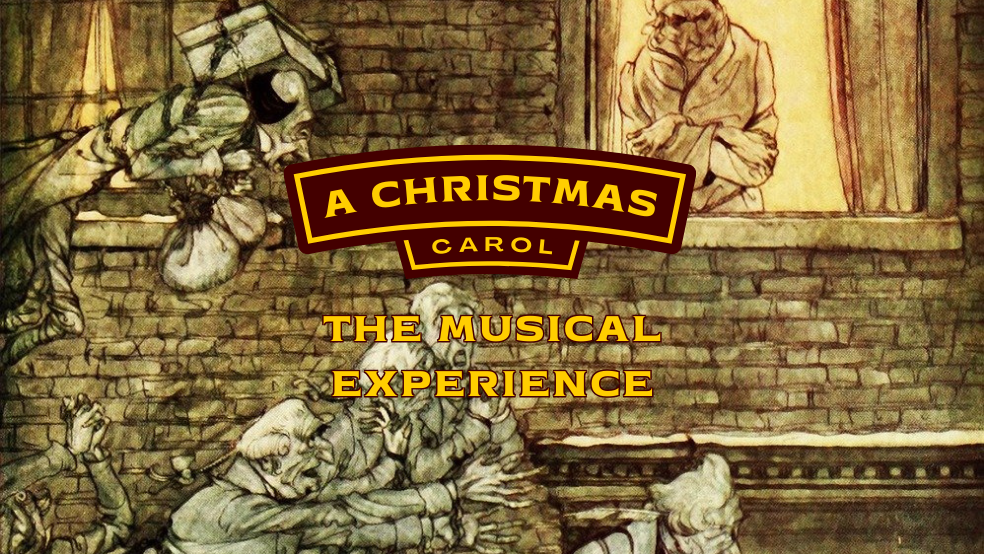
I wrote a musical! This is my third, not counting my two produced operas, AND … I wrote all the songs for this one with my UKULELE in hand. I just finished formatting everything and uploading it to my new Fablelight Media project. You can become a free member (or make a pledge to support the project) and download all the lead sheets (with music, words and chords) at https://www.patreon.com/posts/sheet-music-106577193
The script and minus tracks (accompaniments) are also available. Links on the page.
Be Strong in the Lord & The Whole Armour of God (Ephesians 6:10-18)
Get free sheet music for Be Strong in the Lord & The Whole Armour of God (Ephesians 6:10-18) at https://www.patreon.com/posts/be-strong-in-of-103872859
Catch up with Project Paul on Patreon at https://www.patreon.com/collection/95172 (including all free sheet music) or bookmark the playlist to listen/watch on YouTube at https://www.youtube.com/watch?v=JASmZl4X6d4&list=PLa626nR993Oy4reMVF4cqEFvMGfaAQNU9&ab_channel=Uke%26Me
This lengthier entry for Project Paul is actually two settings, the first of which segues into the second. Either could be performed on their own, with just a chord substitution noted in the sheet music at the end of the first. I took quite a bit of liberty in repeating or going back to key phrases of the source text. I really enjoyed practicing and singing this one. I hope you enjoy its many moods as well!
“… be strong in the Lord, and in the power of his might. Put on the whole armour of God, that ye may be able to stand against the wiles of the devil. For we wrestle not against flesh and blood, but against principalities, against powers, against the rulers of the darkness of this world, against spiritual wickedness in high places. Wherefore take unto you the whole armour of God, that ye may be able to withstand in the evil day, and having done all, to stand.”
Ephesians 6:10-18
“Stand therefore, having your loins girt about with truth, and having on the breastplate of righteousness; And your feet shod with the preparation of the gospel of peace; Above all, taking the shield of faith, wherewith ye shall be able to quench all the fiery darts of the wicked. And take the helmet of salvation, and the sword of the Spirit, which is the word of God: Praying always with all prayer and supplication in the Spirit …”
Let Us Be Content
Free sheet music at https://www.patreon.com/posts/let-us-be-102788622
Happiness is so dependent on our thoughts, and thoughts of gratitude and contentment for the things we have make up a great portion of that good feeling. People living in impoverished nations consistently rank higher in studies of happiness than we do in the states, not because they have more, but because they’re happy with what they have. Striving has been a great source of stress and unhappiness in my life, and though it was a hard pill to swallow, I have tried to let this verse seep into my heart.
1 Timothy 6 : 6-8 But godliness with contentment is great gain. For we brought nothing into this world, and it is certain we can carry nothing out. And having food and raiment let us be therewith content.
We Shall Ever Be with the Lord – Project Paul (Free Sheet Music)
Find free sheet music for this setting at https://www.patreon.com/posts/we-shall-ever-be-102476851
1 Thessalonians 4:16-17
For the Lord himself shall descend from heaven with a shout, with the voice of the archangel, and with the trump of God: and the dead in Christ shall rise first: Then we which are alive and remain shall be caught up together with them in the clouds, to meet the Lord in the air: and so shall we ever be with the Lord.
Ukulele Club: Easter Season
In honor of the Easter season we’ll be doing the classics Amazing Grace, Ride On King Jesus, and a new song from the 2024 youth album Disciple of Christ: Savior of My Soul. RSVP for April 10th, 6:30-7:30pm at https://forms.gle/ApNxYUkJZsw6oiLV9 and download the free music to bring on your device or print. If there’s extra time we’ll tackle more of Blue Skies.
Uke Club: Spring in Full Swing
Utah County Ukulele Club: With Spring in full swing, we’ll be visiting a few songs with a focus on the change of the seasons. RSVP for March 27th, 6:30-7:30pm at https://forms.gle/ApNxYUkJZsw6oiLV9 and download the free music at https://www.patreon.com/posts/100862693 to bring on your device or print. We’ll tackle a medley of super easy ‘primary songs’ that evoke melting snow, rain falling, the return of birds, and the life-giving effects of little streams. Then we’ll visit the well-known Spanish folk song De Colores, which celebrates the return of the Spring’s colors. Wrapping up, we’ll begin work on Blue Skies, the famous Irving Berlin jazz standard – this one has a bunch of chords, so we will return to it in coming weeks.
Ukulele Bootcamp Now Completely FREE
The online version of Ukulele Bootcamp is where you will learn all about ukuleles, how to learn a song, stretches and warmups, tuning, holding the ukulele, how to read chords, strumming, tablature, the C scale, your first chords and a dozen songs. Over a decade of ukulele teaching went into creating this course and now you can enjoy it for free.
Walk in Love (Ephesians 5:1-2)
A bit of a campfire song. This one is the last of those I recorded in ‘wave 2’ of this project. It may be into 2024 before I record more settings, with the Christmas season now in full swing.
Visit Project Paul for free sheet music for this and all my other settings released so far of verses from Paul’s letters.
Be Ye Kind (Ephesians 4:31-32)
With a moderate swing … “Let all bitterness, and wrath, and anger, and clamour, and evil speaking, be put away from you, with all malice: And be ye kind one to another, tenderhearted, forgiving one another, even as God for Christ’s sake hath forgiven you.”
Visit Project Paul for free sheet music for this and all my other settings released so far of verses from Paul’s letters.
The Household of God
Another setting from Project Paul (now with 10 songs posted), The Household of God, is now available as a free sheet music download at https://www.patreon.com/posts/household-of-god-92032444 along with a demonstration video. You don’t need to be a patron to download this music, though support is appreciated. Enjoy! Ryan
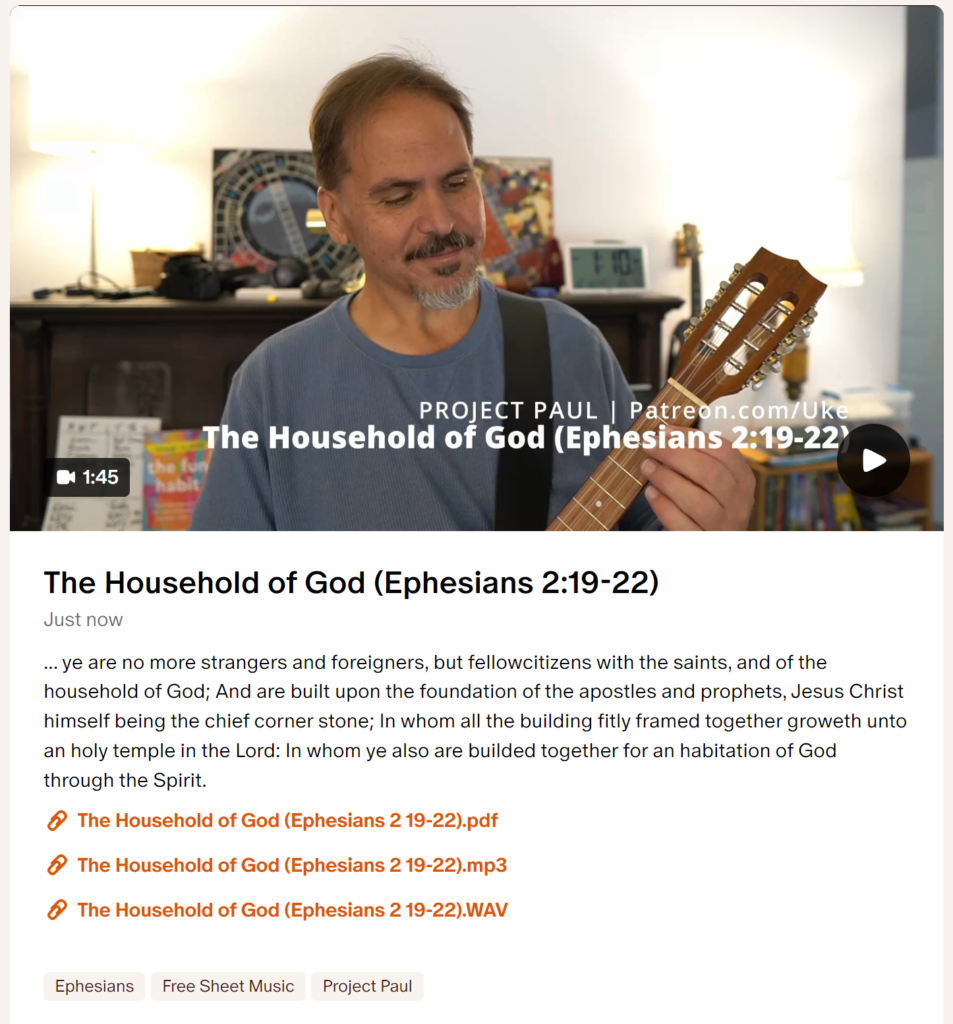
Project Paul
I wrote these settings of Paul’s epistles hoping to get to know him and his writings better. I’m sharing them freely (videos, mp3s, PDFs, chord chart). The first 8 of the settings are now available at bit.ly/projectpaulmusic
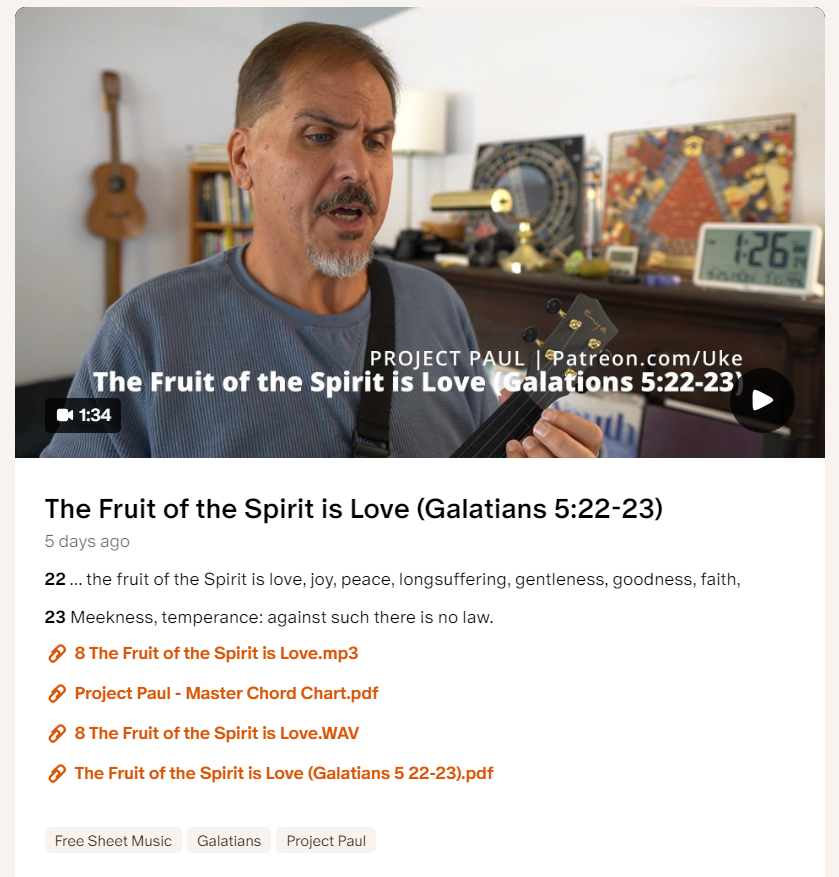
Not Ashamed of the Gospel of Christ
I began writing these scripture settings last year, focusing on the epistles of Paul, simply because I’ve always found his writings a little difficult and I wanted to lean in and understand them better. Looking for scriptures to set to music really makes you slow down and read carefully … something beautiful, uplifting and concise. I thought this scripture particularly, the latest I’ve set, would make a good introduction to Paul and his letters. Free sheet music at https://www.patreon.com/posts/82809358 .
50+ Holiday Songs to Hit the Billboard Charts
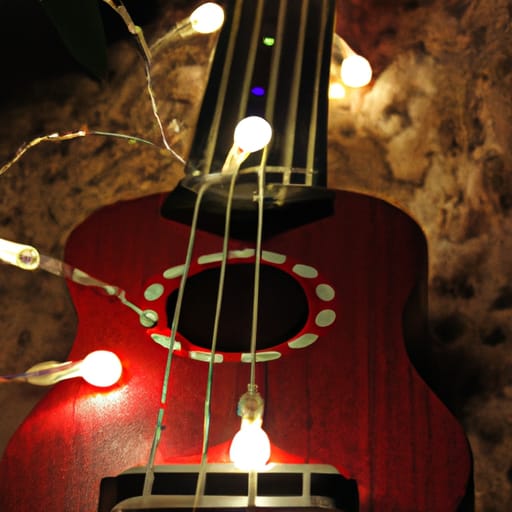
I generally don’t mind most holiday songs (with the exception of ‘Last Christmas’ which sounds like it was written by a tween – the inclusion of the word ‘special’ really gets my goat), and generally I am a sucker for the romantic ones that aren’t really about Christmas at all (I’ve got Your Love to Keep me Warm – Ella & Satchmo have got my number). Before going through this data though, I had never heard of many of these songs before. Instead of dwelling on the bad pennies, some surprised me by being clever, poignant or well-written … AND I was glad to see a trend of more actual Christmas songs breaking into this mostly secular list in recent years.
- Better Days (Goo Goo Dolls) – I may not agree with every word of this song, but it seems heartfelt and sincere and promotes forgiveness … one of Christ’s key teachings.
- Child of God (Bobby Darin) – Who doesn’t love a good spiritual? This got on in the early days of the Billboard charts, in the early days of the folk revival.
- Christmas for Cowboys (John Denver) – A simple song that recognizes simple gifts and acknowledges Christmas as a day for prayer, even for cowboys. I love Denver’s voice.
- Christmas Tree Farm (Taylor Swift) – I honestly don’t know what to make of Taylor Swift, but this is a nice addition to the holiday love song category. I really like the image of having a Christmas Tree Farm in my heart, growing lovely green trees that will go out to bring joy to the world. “Sweet dreams of holly and ribbon / Mistakes are forgiven” expresses that forgiveness theme and is a nice slant rhyme to boot.
- Favorite Time Of Year (Carrie Underwood) – A feel-good song, maybe not poignant, but fun.
- Hallelujah (Carrie Underwood & John Legend) – NO! It’s not a Christmas adaptation of the overly-covered Leonard Cohen song. A lovely duet that hints at real Christmas themes … “Let the world stand still, the church bells ring, Silent night as the angels sing, Hallelujah, Hallelujah … Ooh, let thеre be peace on earth, Let the lonely join together, let them know their worth, Ooh, let the children know, There’s a brighter day ahead (let’s hold on to hope).”
- It Doesn’t Have to Be That Way (Jim Croce) – It’s Christmas, let’s get back together! Why not? Nice to hear something folk-y on the list. 🙂
- Like it’s Christmas (Jonas Brothers) – Another fun addition to the holiday love song category.
- Mistletoe (Justin Bieber) – Most songs in this list do their best to ignore the elements of the Christmas story … even though its making a love song metaphor, I like the phrase “the wise men followed the star, the way I followed my heart” (which assumes people know the story of the wise men). Minus points for using ‘shawty’.
- Silent Night (Carrie Underwood) – It was nice to see the actual most popular Christmas song of all time make a blip on this list devoted to radio play.
- Someday at Christmas (Lizzo) – A recent cover of this Stevie Wonder Christmas against War song. The years have a had number of these kinds of songs, particularly coming from the sixties and seventies. I hadn’t heard this one before, and as it led me to Stevie Wonder’s original, I was glad to hear about it.
- Take Me Home For Christmas (Dan + Shay) – I like that the protagonist of this song is brave enough to declare to his sweetheart “take ME home for Christmas” instead of imploring Santa to drop off a relationship at the door. It’s a good image, giving yourself as a gift at Christmastime.
- The First Noel (Gabby Barrett) – Yea! Another traditional real Christmas song to blip into the top 100.
Well, that’s it. Almost everything else new was a variation on “All I Want for Christmas is You.” The other songs on the list, many of which I like, are so common as to need no commentary. Here is the list I compiled of almost every holiday song that has been on the top Billboard charts since they began in the late 1950s (may this list, checked twice, provide you some inspiration for new songs to play):
- A Holly Jolly Christmas (Burl Ives)
- All I Want for Christmas is You (Mariah Carey)
- Baby, it’s Cold Outside (Dean Martin)
- Better Days (Goo Goo Dolls)
- Blue Christmas (Elvis Presley)
- Child of God (Bobby Darin)
- Christmas (Baby Please Come Home) (Darlene Love)
- Christmas for Cowboys (John Denver)
- Christmas Tree Farm (Taylor Swift)
- Cozy Little Christmas (Katy Perry)
- Deck the Halls (Nat King Cole)
- Favorite Time Of Year (Carrie Underwood)
- Feliz Navidad (Jose Feliciano)
- Hallelujah (Carrie Underwood & John Legend)
- Happy Holiday | The Holiday Season (Andy Williams)
- Happy Xmas (War is Over) (John & Yoko)
- Have Yourself a Merry Little Christmas (Michael Bublé)
- Here Comes Santa Clause (Gene Autrey)
- I’ll be Home for Christmas (Josh Groban & Kelly Clarkson & Bing Crosby & Camila Cabello)
- It Doesn’t Have to Be That Way (Jim Croce)
- It’s Beginning to Look a Lot Like Christmas (Perry Como)
- It’s the Most Wonderful Time of the Year (Andy Williams)
- Jingle Bell Rock (Bobby Helms)
- Jingle Bells (Frank Sinatra)
- Last Christmas (Wham!)
- Let it Snow! Let it Snow! Let it Snow! (Dean Martin)
- Like it’s Christmas (Jonas Brothers)
- Mary Did You Know? (Pentatonix)
- Mele Kalikimaka (Bing Crosby and the Andrews Sisters)
- Merry Christmas (Ed Sheeran & Elton John)
- Merry Christmas Baby (Chuck Berry)
- Mistletoe (Justin Bieber)
- Oh Santa! (Mariah Carey)
- Pick Out A Christmas Tree (Dan + Shay)
- Please Come Home for Christmas (Eagles)
- River (Sarah McLachlan)
- Rockin’ Around the Christmas Tree (Brenda Lee & Justin Bieber)
- Rudolph the Red-Nosed Reindeer (Gene Autrey)
- Run Rudolph Run (Chuck Berry)
- Santa Baby (Eartha Kitt)
- Santa Claus is Coming to Town (Jackson 5)
- Santa Tell Me (Ariana Grande)
- Santa, Can’t You Hear Me (Kelly Clarkson & Ariana Grande)
- Silent Night (Carrie Underwood)
- Sleigh Ride (The Ronettes)
- Someday at Christmas (Lizzo)
- Take Me Home For Christmas (Dan + Shay)
- The Chipmunk Song (The Chipmunks)
- The Christmas Song (Nat King Cole & Lauren Daigle)
- The First Noel (Gabby Barrett)
- There’s No Place Like Home for the Holidays (Perry Como)
- This Christmas (Chris Brown & Donny Hathaway)
- Under The Mistletoe (Kelly Clarkson and Brett Eldredge)
- Underneath the Tree (Kelly Clarkson)
- What Can You Get a Wookie for Christmas
- Where are You Christmas? (Faith Hill)
- White Christmas (Bing Crosby & The Drifters)
- Wonderful Christmastime (Paul McCartney)
- You’re a Mean One, Mr. Grinch (Thurl Ravenscroft)
Which are your favorites? Which do you never want to hear again? What songs are new surprises for you?
